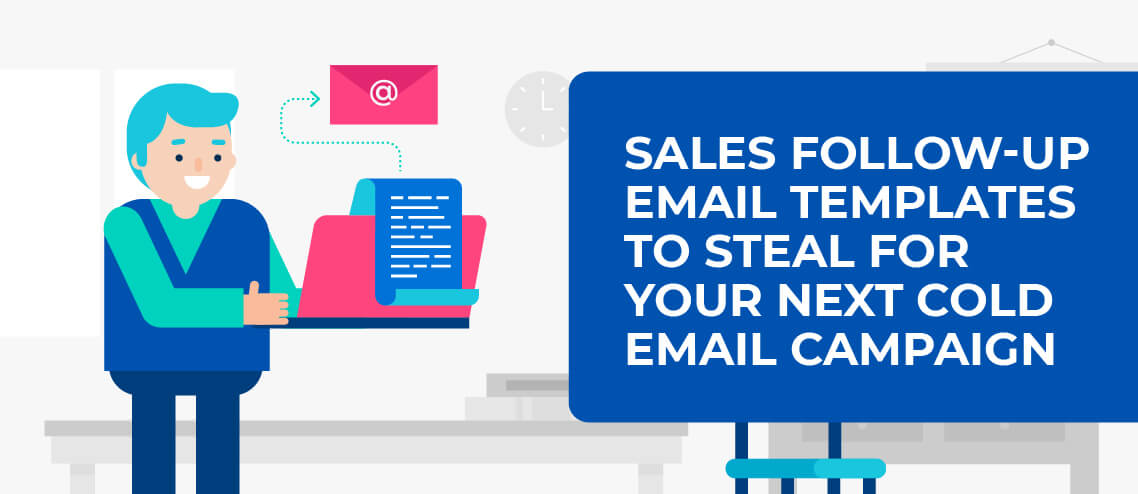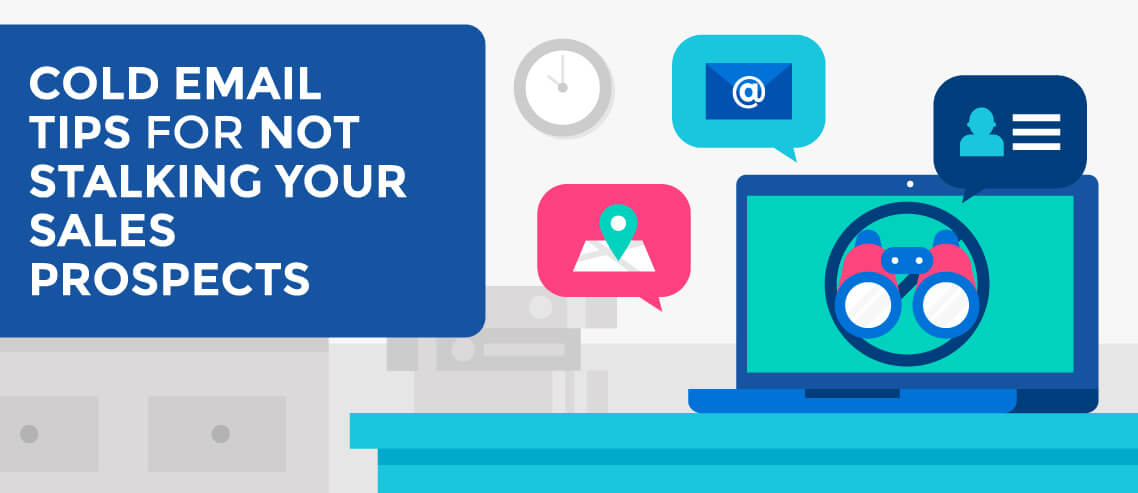How to Supercharge Your Cold Email Campaign: Guide for Consultants and Small Agencies
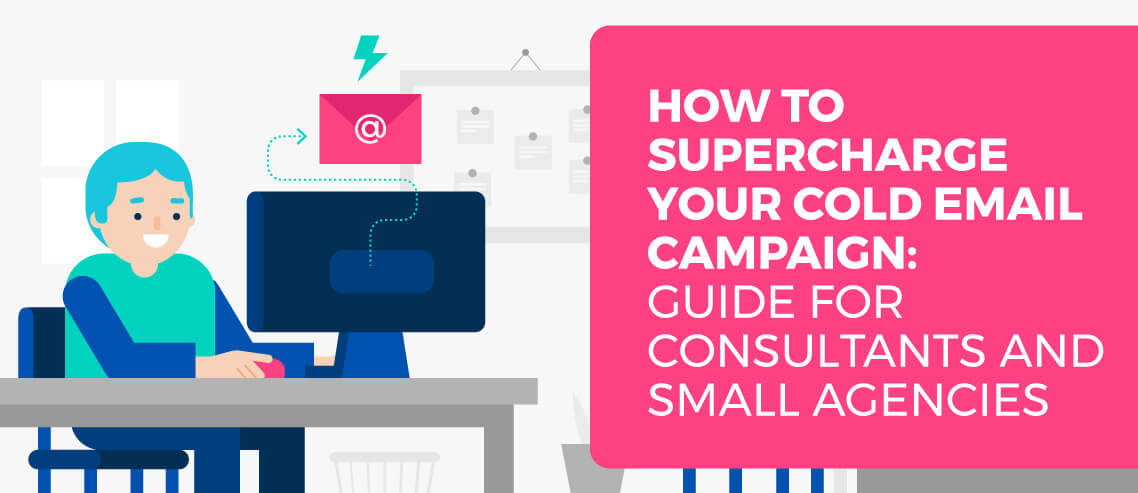
Contents
The cold hard truth is that most consultants and small agencies don’t know how to cold email. That often-touted open rate of 2% for cold emails says so.
And no one dares disclose their reply rates, because they’re lower than a snake’s belly.
But you can get stellar open rates… and jaw-dropping 10% or higher reply rates on your cold emails. You just gotta know how to write ’em right.
When I launched my marketing business, I trusted its growth to cold emails – a.k.a., the elusive white unicorn stalking the marketing forest. Roughly 4 months after launching, I’d grown my business 14x using only cold email. My campaign had a 56% open rate and a 9% positive reply rate.
Plus, one single cold email brought in $20,000 in revenue.
Best of all? This is a repeatable formula.
Recently, I had the honor of helping Citygreen’s consultants send cold emails to book more sales meetings. The campaign had a 33% uplift in reply rates compared to their previous one. (Why is that so important? Because open rates won’t make one difference to your bank account.)
That’s the kind of rocket-fuel growth you want, right? Cool. Stick with me, and I’ll show you how to write a cold email that will get you those kinds of amazing results.
Be relevant
A small blogger doesn’t just sit around wondering how a consultant or small agency can help them convert more customers through their Stripe account.
So, if you send them a bad cold email like this one that I recently received, guaranteed they’ll delete it:
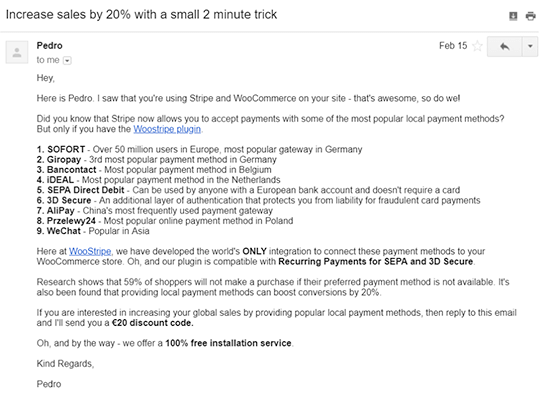
Maybe you’re thinking, “But this email is personalized and that’s what cold emails need to be. Haven’t you heard that personalization is ‘critical’ to success, according to 94% of businesses in one survey?”
You’re right – personalization is a good place to start in your cold email. But your email could be so much more awesome.
How? By being relevant to your cold email reader.
Here’s why that’s critical: Business professionals – like the ones you’re planning to cold email – get an average of 84 emails per day.
Being relevant to your reader is the secret sauce that makes a cold email stand out and grab attention – by feeling warm.
What’s relevance, really?
It shows your reader that you get them. And by understanding them, you’re a partner aligned towards their success. You just might solve their problems. You just might make them more money.
Let’s go back to that bad cold email example. I rewrote it, so it’s now relevant to their reader:
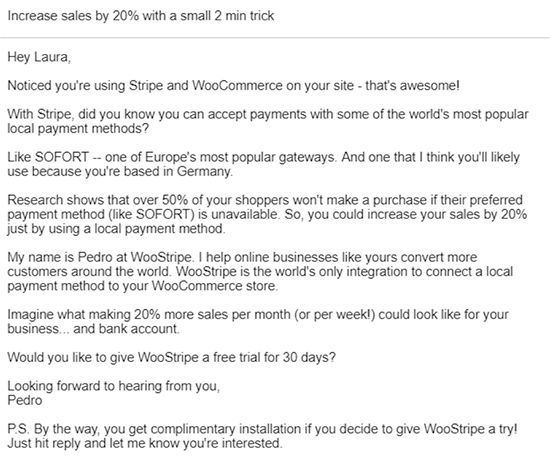
Every single line is oriented towards the reader and being relevant to her desires and goals. It answers her question: “What’s in it for me?”
It’s a universal question. You think it when someone asks you to do something. I think it, too.
So, when you answer that question for your reader and put your message in the context of what your reader gets out of performing X action, you eliminate friction and make their decision easy.
Want more relevance? Here’s a killer cold email consultant example from Ramit Sethi. I underlined in red every spot where this cold email writer was relevant to Ramit’s viewpoint, goals, and problems:
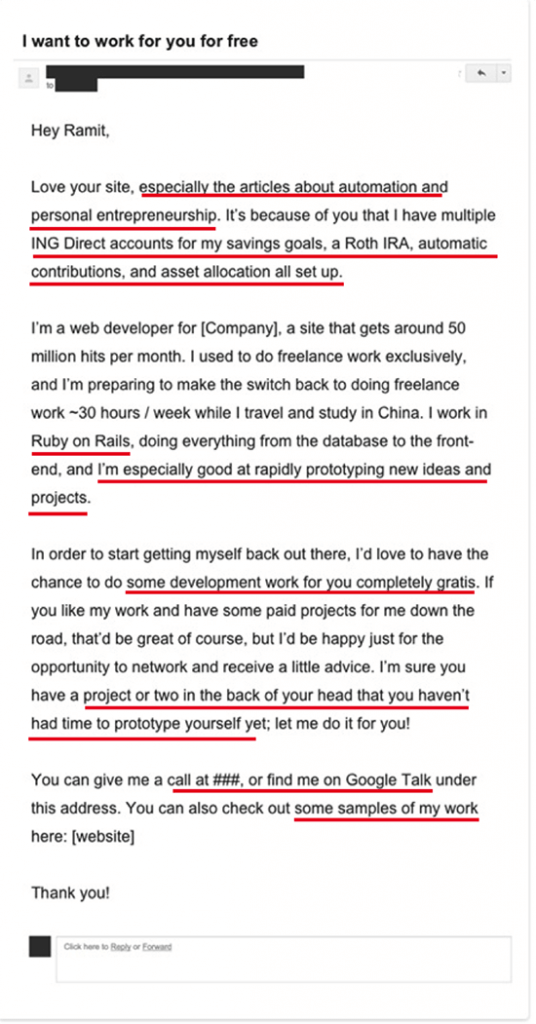
Look at all that beautiful red relevance. No wonder Ramit said, “I called him within 60 seconds of reading this.”
All right, so you want to be relevant. Now, how do you actually do that?
4 steps on how to be relevant
1. Frame your message
Think of framing as helping your cold email reader put into context what you can do for them.
For example, check out Van Gogh’s Starry Night in a yellow frame. All you see are bright yellow stars and moon – NOT the blue night and fields, right?

That’s framing. You’re helping your reader see what you need them to see.
As Stuart Diamond wrote in Getting More: How to Negotiate to Achieve Your Goals in the Real World:
“Figuring out how to frame things comes from asking yourself the question, ‘What’s really going on here?’ Studies have shown that one person will be much more persuasive than another with the exact same facts because of framing. The more successful negotiator packages the information in a way that creates a different picture in the other person’s head.”
Do the heavy lifting and put your message into context for your reader.
Connect the dots for them on how you can solve their problem. Don’t expect them to do it for you, because they won’t.
2. Link your offer to [your best guess] their business goals
Chances are their business goals include one (or more) of the following:
- Make more money
- Get more clients
- Reduce expenses (or taxes)
- Increase business growth via reach, market share, network
- Look awesome to their boss or client
Steal a page from the best-in-class B2B content marketers’ playbook: 71% of them tailor their content to their reader. That means taking personalization to a whole new level, well beyond the simple insertion of a name and job title.
Kathy Sierra, the author of Badass: Making Users Awesome, says it best:
“Find out what they do, need, and want, and map what you offer [that is, what you’re selling] into something meaningfully relevant for that person.”
In your email, you should:
- Create a relevant subject line
- Use their name in salutation
- In the opening line, include a compliment on a recent win/accomplishment
- OR in the opening line, create a connection of like-minded activities
- Include a CTA
- Use examples tying their business goal to your offer
What does “use examples tying their business goal to your offer” really mean?
In Citygreen’s cold email campaign, their offer was to help landscape architects save 20-30% on their next project. Because of my research, I knew budget was a huge concern for Citygreen’s cold email readers.
So, this email hits that point hard in two places – the subject line and lead-up to the CTA:
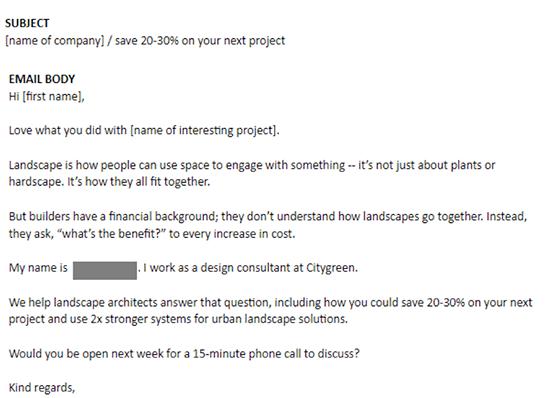
When you tie your offer into your cold email reader’s business goals, you create motivation to fuel their action. Suddenly, your inbox overflows with replies, like the 33% uplift that Citygreen saw with this campaign.
3. Research your reader
So, how do you find all those juicy details to add into your cold email?
Research, my friend.
Dig deep and figure out exactly who you’re emailing. Only then can you write a cold email that a) feels natural and non-salesy and b) gets your reader to convert + hit reply.
For this Citygreen project, I researched their cold email reader by:
- Reading unedited, raw customer interviews
- Reviewing their readers’ business websites
- Conducting competitor assessments
- Hunting down a theme that ties people in similar jobs together (like what led them to pick that job)
When Kyle Racki, co-founder and CEO of Proposify, got a cold email from Trey, he had to hit reply.
That’s because Trey showed that he knew Kyle cares about delivering great experiences to his SaaS customers, not about growth or revenue.
That’s what hooked Kyle: “Trey has taken the time to research Proposify and show how the tool can be used on our own website. It’s all about ME, not him.”
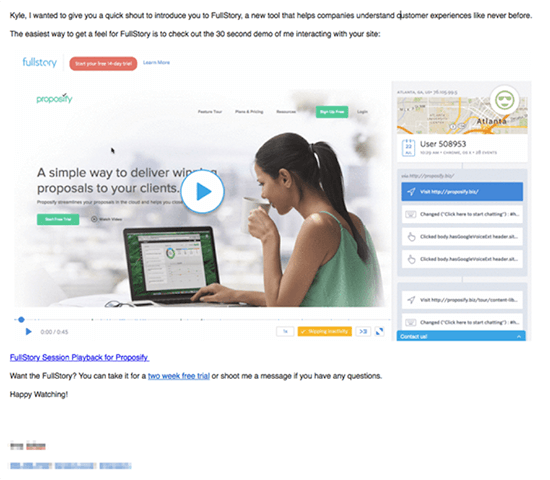
Research is the only way you’ll know what to say and how to say it, and get your cold email reader dying to hit reply.
4. Be generous with flattery
You want to warm up your cold email so that instead of it feeling like it’s coming from a stone-cold stranger, it feels like it’s from a colleague of a colleague. A compliment is how you do that.
As a recent study showed, the recipient of a compliment was more likely to choose a coupon from the store that complimented them vs one that hadn’t, even when they knew that compliment wasn’t sincere. The positive feeling from the compliment still lingered and influenced their behavior.
Talk about sticking power. Talk about persuasion.
Be genuine with your compliment. If it’s not common knowledge, reference where you unearthed that info nugget.
5. Share a taste of value
Give your cold email reader an idea of what they could do with your service.
Meaning: give them a little bit of value so they get on the right path, so they start imagining how they could use your service or what their life could look like.
Check out the red highlights in this cold email that I engineered for Citygreen. These are the spots where the email provides value to the reader by:
- Helping them see it’s possible to save 20-30% on their next project
- An idea of who can help them accomplish that
- That it’s possible to use a 2x stronger system while saving money
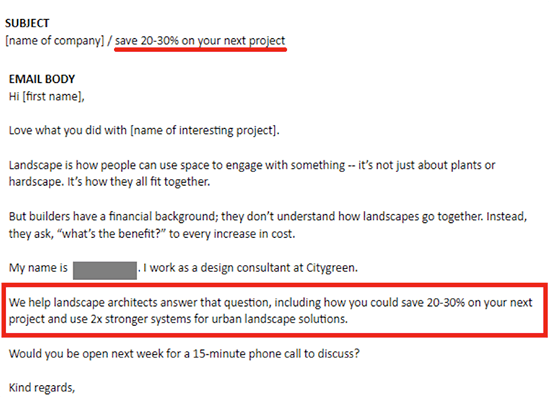
This technique establishes you as a) an expert who b) isn’t threatened by giving away a little value and c) only wants to help which d) removes their initial distrust. (Especially when it comes to reading this cold email, which is usually seen as a sleazy sales email.)
In conversion copywriting, this is known as the PAS method, which stands for:
- Problem
- Agitation
- Solution
You introduce the problem, agitate it, then end with the solution which is tied to your service. It’s a killer persuasion technique that works wonders for cold emails.
Sean Bestor at Sumo recommends you do research on their business to pinpoint where they can improve – specifically by using your service:
“Once you point out the bad, you get to be the hero and fix it. The most important note here: DO NOT SELL YOUR PRODUCT. Instead, focus on how to help instead of sell. Right now your lead doesn’t care about your product. They just want to fix their new problem you just brought up.
And that’s the bulk of the ask in the first cold email. I didn’t mention the company, or the product, or what my freaking role is. I just said I had a solution to their problem. It’s short, to the point and provides a lot of value to the lead.”
Ramit Sethi puts it more bluntly:
“You need to find out the problems they’re having that you can solve. This means deeply understanding their hopes, fears, and dreams before you pitch them.
For example, say you notice they’re doing more video and you know a way they can improve them to get more subscribers. Tell them. In fact, go ahead and do it for them.”
So, here’s how you write your all-important CTA
When you write your call to action (CTA), think about what you need your reader to do next.
Break down the tiniest next step that someone needs to take towards becoming your client, and ask your reader to take that step. For example, in most sales funnels for consultants or small agencies, the next step is a consult call.
What’s the tiniest next step your cold email reader needs to take? To book that call.
So, that’s what your CTA should ask them to do.
When you make that ask, assume your reader will say yes. Skip over the friction of asking them to check their calendar, decide which day works for them, schedule through Calendly – or heaven forbid – think.
As Joanna Wiebe of Copy Hackers and co-founder of Airstory points out:
“If you ask a yes/no question hoping for a ‘yes’ answer… what happens if your prospect answers ‘no’ instead? You need to phrase all your questions in such a way that the prospect has to answer in agreement with you. And if you can’t do that, delete the question. Why? Because you do NOT want your prospect to shake their head at you. That ‘no’ interrupts the seduction. It makes them think you don’t actually understand them after all.”
Assume they’ll say yes and phrase your CTA that way, such as:
“Would you be open next Tuesday or Wednesday for a quick 15-minute call to [insert their business goal]?”
A simple formula to use for your CTA is:
“Are you available next [specific date] or [specific date] [when, i.e. next week ] for a quick [duration of call; ideally, no more than 15 mins] [type of call: phone call, web conference call] to [accomplish their business goal; like ‘help you increase your webinar funnel conversions by 30%’]?”
Testing is vital
When we get to this point, I always tell my clients: “Testing is a learning opportunity to know more about your audience.” Truthfully, you’ll never know for certain what messages work in your cold email until you test.
Got echoing silence from your first cold emails?
Take that as a learning opportunity. Revise your cold email and try again. As Claude Hopkins, the amazing grandfather of direct response marketing, said:
“Tests are important and help us to understand our customers. Good selling is based on good testing.”
One caveat when you’re testing: send small batches at first. I’m talking 5-7 emails. You don’t want to shotgun-spray honestly crappy cold emails.
That’s a surefire way to get your email blacklisted.
So, start small and test:
- Subject lines
- From names (a.k.a. the name that shows up when you send an email)
- Timing of email: day of week, time of day
- Timing of follow-up emails
- CTAs
- Relevance of your offer to their business
- Stats/research proving how your offer would help their business
- Stats on how you’ve helped previous clients
Install tracking software so you know when your email is opened and in what location. This tells you two things:
- If your subject line and from name are working (or not)
- The time zone of your cold email recipient, so that in your follow-up email, you can suggest meeting times in their time zone
I use Mailshake for this. It integrates with your Gmail account, and in addition to helping you streamline the process of writing and sending cold emails, Mailshake allows you to monitor their impact. You can see which emails have been opened (and which haven’t), and even track whether or not links in your emails are being clicked.
This can help you test the effectiveness both of subject lines and the contents of the email itself.
Don’t miss 90% of your opportunities by skipping this important step
Time to be honest: Are you sending follow-up emails?
If not, you’re missing out on 90% of your opportunities to attract a new client.
The good folks at Anymail Finder realized the power of following up when they received 4-5 follow-up emails:
“… and we responded to 90% of them. Why? By the third email you really start to read what they’re saying. Only emails that were completely irrelevant were ignored and even then we’d still consider responding to tell them.”
And this guy on Quora, who received the ‘relentless’ cold email, shares:
“The guy emailed me about 5 times over 2 weeks and here is what is weird…. I didn’t get annoyed, I got more and more interested. 99.9% of people email me once and max twice but when someone emails 5 times and it seems like they really give a damn, that wakes me up. I went from ignoring it to googling the company.”
Hmm, feels like you’re still resisting this idea of following up. Okay, let me share a dirty little secret with you.
Back when I was a litigation paralegal, I’d get hundreds of emails per day. If the sender didn’t send a follow up email, I hit delete and figured it wasn’t important.
Because if it was important, they would’ve followed up.
By sending a follow-up email, you’re helping your cold email reader know that your email is important. You’re helping them prioritize their day.
As Steli Efti, co-founder and CEO of Close.io, says:
“The follow-up is where winning really happens. It’s when everyone else stops running, and you’re the only person still in the race. It doesn’t matter how slow you run—you are going to win because everybody else stopped running.”
If it seems overwhelming to send all those follow-up emails, the right tool can help. Again, I think Mailshake is great for this. It can automatically send follow-up emails for you, in line with recipients’ interactions with your previous emails. For example, you can create a sequence of follow-up replies and if at any point a reply is detected, the sequence will be ended automatically. Simple.
How to Write a Follow Up Email:
Your follow-up email should:
- Be quick and to the point
- Make your follow-up email’s CTA relevant to the first email’s CTA
- Ask only 1 question in the email body
Make that one question you ask very easy to answer or take action on. You’re dropping bread crumbs to lead your reader down a specific path. Don’t make it hard for them by littering it with tasty cookies.
Your goal: to get them on the phone for an initial consult call. Not to buy your introductory package. Not to book you for a project. Not to lock you down for a $X/month project.
Make it easy for them to say yes. Always tie in your CTA with your reader’s business goal. Remember to answer the question rolling in their head: what’s in it for me?
Here are two templates to swipe for your follow-up email:
Hey [name], I’m following up with you on the below email. Would next Wednesday or Friday work for a quick 15-minute chat on how [your offer] can boost [your reader’s business goal]?
Or….
Hi [name], Hope your week is off to a great start. I’m following up with you on the below email. Would you have 15 minutes next week for a quick chat on how I might save you [X hours] per project with [your offer] to get [reader’s company] more [clients, users, revenue, growth]?
Don’t be intimidated
I get it. Cold emails are scary.
To take the edge off your sweaty hands, remember this: you’re emailing a fellow human. They’re just like you and want pretty darn similar things to what you want.
We live in an amazing world where everybody is reachable by email. I’ve connected with NYT bestselling authors like Harlan Coben, Chris Guillebeau, Matt Kepnes, and Ryan Holiday because of email.
More than that, email has a special connecting power that we humans yearn for.
Psychologists Roy F. Baumeister of Case Western Reserve University and Mark R. Leary of Wake Forest University found that human beings are fundamentally and pervasively motivated by a need to belong.
In other words, we’re fueled by “a strong desire to form and maintain enduring interpersonal attachments.”
If you think of your cold email as a way to give a stranger directions to a nearby Starbucks – when they’re badly in need of a coffee fix – it’s easier to hit send.
Your cold email is the first step in helping them get what they want. It’s the handshake. It’s the little “yes” that could lead to bigger yeses.
Avoid 3 major mistakes in your cold email
1. You send out a TON of cold emails on your first go-around
Please, don’t do this. It’s the quickest way I know of to get your email named as spam or blacklisted.
Your fix: Don’t send out more than 10 cold emails per week. Once your email is consistently getting opened and has positive replies, then open up the throttle.
Always be respectful, relevant, and add value.
2. You don’t send any follow-up emails
Say you’ve sent out a few cold emails, had 1 or 2 replies, and now you’re in a pickle. What do you do with the other emails that didn’t reply? You’re faced with too many uncertainties and unknowns, so… you don’t do anything.
Your fix: Put on your big boy pants and send that darn follow-up email. Schedule Boomerang to return your original cold email to your inbox after 3 business days if no reply.
3. You aren’t specific
Your cold email is filled with mumbo-jumbo jargon that nobody really understands – even you.
Your fix: Specificity is the nectar of high-converting email copy.
When you’re specific, you’re relevant – and you show that you understand your cold email reader. You get them, which can be highly persuasive. You know he’s a fan of the Philadelphia Eagles and, more specifically, of the Donovan McNabb era? Mention that.
Cold emails can – and do – work.
Once you craft a cold email that’s relevant to your reader, you’ll stand out in the crowd. Soon, your consulting business or small agency will begin to reap the benefits.
So, figure out who you’ll connect with… and start drafting that cold email.


